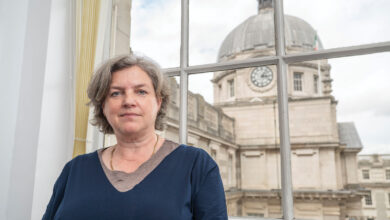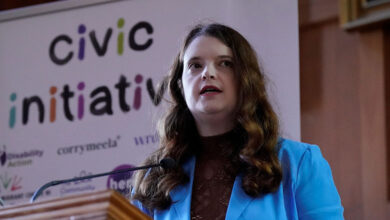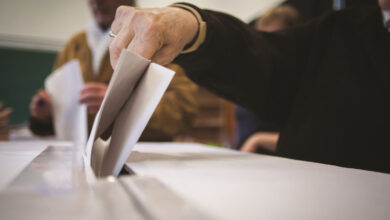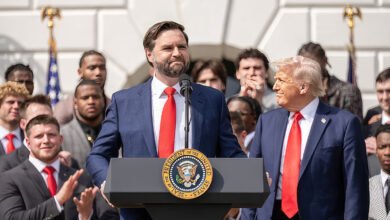Collecting for the future

William Blair, Director of Collections at National Museums NI, talks to Owen McQuade about the unique and wide-ranging collection at the Ulster Museum and the challenges of managing and developing the collection in a post-conflict society.
The Ulster Museum on Belfast’s Stranmillis Road has been 200 years in the making. It has its origins in the Belfast Natural History and Philosophical Society in the late 1830s and relocated from the city centre to its current location in Botanic Gardens in the 1920s.
The partition of Ireland gave impetus to its development with the foundation of the new entity of Northern Ireland keen to strengthen its status.
The Ulster Museum as we know it today came about in the 1960s when legislation transferred its ownership from the municipal authority to central government with a board of trustees which is still the model of governance of today. The museum also developed physically over this period, with the new modern extension to the neo-classical building opened in 1972. Terence O’Neill was the driving force behind the museum’s development, initially as Finance Minister and then as Prime Minister.
“Although O’Neill’s tenure is contested in terms of effectiveness and authority, his most enduring legacy is setting up the Ulster Museum and Ulster Folk Museum,” says Blair. “Whilst his liberal reform agenda was seen by many as ‘too little, too late’, the museums he helped to establish are ‘here for good’; the backbone of our cultural infrastructure, enjoying an international reputation.”
A central feature of these museums is history. “Our history is very much alive in Northern Ireland. It continues to manifest itself in the present and to shape our identity. Museums are not simply about housing the past – that is a misconception – they are very much about the present and where we might be going. Museums, at their best, open perspectives on the emerging future. That is where museums become relevant; supporting engagement and dialogue around who we are today, where we are going and what kind of society we want to create together,” he explains.
In 2009, Blair joined the Ulster Museum with the “ambitious” job title of Head of Human History. Six years later, he became Director of Collections which was “much more meaningful” and saw him take on a much broader remit across curatorial, collection services, and audience development. A core part of his current role is the strategic management and development of a collection that spans art, history, and natural sciences. “The scale and diversity of the collection makes us a museum of national and international significance,” he adds.
When Blair took up his post, he wrote a paper on ‘Unlocking the potential of the collection’, “which still encapsulates the fundamental challenge and opportunity; it is an incredibly diverse collection and, importantly, a huge learning resource”. Blair believes that it is a body of evidence and source of inspiration “that has so much to contribute to society not just in how we face our local challenges but our global challenges”.
Multi-disciplinary
Blair highlights the Ulster Museum’s art collection, saying “art collections open a window on human experience; the artists’ response to the world around them”. In Northern Ireland, the Ulster Museum also serves as a national gallery, collecting both historic and contemporary art. The collection is not geographically confined and can stretch to what is relevant internationally “as many of our challenges are now global”. For example, some recent acquisitions reflect the Black Lives Matter movement; a global movement that has reverberated in Northern Ireland. Another example of the international aspect of the collection is the natural science collection that holds data on biodiversity, which is of interest to scientists locally and globally. “By holding specimens, we can see what has changed, what used to be here and what is not here now. It allows us to map what is happening to our natural world and identify strategies to help address environmental change and biodiversity loss.”
Metaphoric symbolism
In 2022, the Ulster Museum marked its fiftieth birthday in its current form. Blair sees the building itself as a powerful metaphor, with the neo-classical traditional idea of what museums are; a centre of authority, with its ionic columns. “The Ulster Museum takes that and moves it on, combining it with the modern extension. In many aspects, it could not be a better combination and that mix gives the Ulster Museum its identity – a place for bold new perspectives, just like the building, where you can explore the past and debate the future. It is also a bit like a Tardis; under one roof you have art, history and natural sciences. An à la carte menu for any particular visitor. You can go back in time to the Big Bang, to understand how our planet and solar system has evolved over millions of years.

“At the same time, our Troubles and Beyond gallery – which focuses on our recent past and where we are now – holds a mirror up to who we are today. Northern Ireland today is a fascinating place; a society that is constantly evolving and changing, but one where traditions still matter. Inevitably there is much suppressed trauma in this society, that is an inevitable legacy of the hurt and injury caused by the conflict,” he states.
The big challenge for Blair is keeping pace with change: “Understandably, we have spent considerable time and effort in understanding and interpreting our traditional divisions. But this society has become much more diverse, especially over the past 10 years or so. That is very enriching for all of us, but it presents new challenges for the museum in effectively representing that growing diversity in our collections, exhibitions and programmes.”
Decolonisation
This shades into the agenda of ‘decolonisation of the museum’. Blair explains that decolonisation of the museum can be a misleading or confusing term. Instead, National Museums NI frames its work around the concept of ‘Inclusive Global Histories’. He comments: “That is more positive and meaningful. It expresses more clearly our approach. Our World Cultures collection is not particularly large, but it is undoubtedly important. It inevitably reflects the history of colonisation, with material from around the world. For example, it includes and collection of around 500 items from Africa, but as our society includes people of African descent living in Northern Ireland, it is not just about repatriating. It is also about how we involve diverse communities in decision-making, what to do with the material, and how we interpret the collection here in Belfast.” Blair acknowledges that repatriation is an important element of the work “but many people think it is the entirely of the process, and that is simply not the case. We can also achieve positive outcomes through transparent and meaningful local engagement”.
Ethics
“Ultimately the test is one of ethics,” the Director of Collections says, indicating that the Ulster Museum responds to any request with a sense of urgency and purpose. For example, the museum recently repatriated some important cultural religious objects and ancestral human remains to native Hawaiians. In most instances, Blair says the issue is clear cut; if it involves human remains, items of religious significance, or indeed, any items collected unethically in the past, then he believes museums must do the right thing by the indigenous communities from where they emanated.
“The issues can be complex, but making the right decision creates opportunities to build new relationships and a collection that facilitates greater mutual understanding and respect for cultures. Our programme ‘Inclusive Global Histories’ proactively seeks to work with representatives from source and diaspora communities who can then be part of the conversation on how we use and interpret these collections. And how we promote in a positive way the respect for cultures that created those objects.
Museums, at their best, open perspectives on the emerging future.
“If those objects could speak, they would not say ‘I am a colonial object and I do not know how I got to Belfast’. They would introduce themselves on the basis of the cultures that created them and their actual meaning and cultural significance. Then they might explain how they got to Belfast, and their desire to return home (or stay).”
National Museums NI has an ethics policy that gives it a clear reference point that guides its decision-making. It manages the collection of 1.4 million specimens in line with its collection development policy which includes not just acquisitions but also the process for the transfer, reuse and disposal of collections. This is a carefully considered process because museums must maintain public trust.
‘The Troubles’
The Ulster Museum’s work around conflict and legacy is primarily delivered through a programme called ‘The Troubles and Beyond’. “The challenge is what to collect, how to collect it, and how to display it, as well as determining what stories to tell through the collection. Clearly, there are sensitivities given the diversity of perspectives on the conflict. Our recent past is complicated and within the living memory of most people. We all have the truth of our own lived experience and that must be respected. We see our work in this area as an open-ended conversation.
“It is a learning journey and we deliberately asked visitors to ‘The Troubles and Beyond’ exhibition in the Ulster Museum what they think is missing. Can they help us tell this story better? It is an open-ended process and the gallery is continually evolving and being refreshed with new objects.”
Overall, visitor feedback has been very positive. Blair sees the gallery as a “conversational space”, that does not focus solely on political history but also seeks to look at the wider economic, social, and cultural changes in society. “It is important to view history in that broader sense. Visitors have their own interpretation of events based on their personal experience, and we must give them enough touch points that they feel that their perspective is included.”

Inclusivity
Inclusivity is a big challenge for museums. Blair says that people can be surprisingly tolerant and accepting of hearing other people’s political perspectives providing they do not feel excluded themselves. “As people move through the galleries, they will see the Ulster Covenant juxtaposed with the Proclamation of the Irish Republic. They are both 18 feet tall. We have never had any objection or graffiti. That is positive and everyone recognises that both documents are important and both are cornerstones of the story of 20th century Ireland,” he says.
The collection also reflects different aspects of identity, its origins and how our identities have evolved over time. The ‘Dungiven costume’ came into the collection in the late 1950s. It was found by a farmer in peatland at Dungiven, County Derry, which had helped preserve it for 400 years. The checked trousers, or ‘trews’, show a connection with Scotland. The doublet, or jacket, is an English garment and the mantle, or cloak, is quintessentially Irish. “In the one suit of clothes you have the DNA of early modern Ulster, reflecting the mix in our society. It is a cultural fusion with distinct elements that still resonate today,” Blair remarks.
“It is important to view history in that broader sense. Visitors have their own interpretation of events based on their personal experience, and we must give them enough touch points that they feel that their perspective is included.”
“It is a real privilege to work with a collection of this size and significance, and to be able to work across the wide spectrum of this society. Whatever challenges we have, I remain optimistic. In my dealings with people, I am always struck by the qualities of people here – their openness, warmth and resilience, especially given what we have gone through during the Troubles. As John Hume used to say, ‘we have far more in common than we have to divide us’.
“The creativity, diversity, and openness that is a feature of post-conflict Northern Ireland undoubtedly provides a basis to build a better future together. I would not want to work anywhere else; it is challenging but very rewarding,” he concludes.





